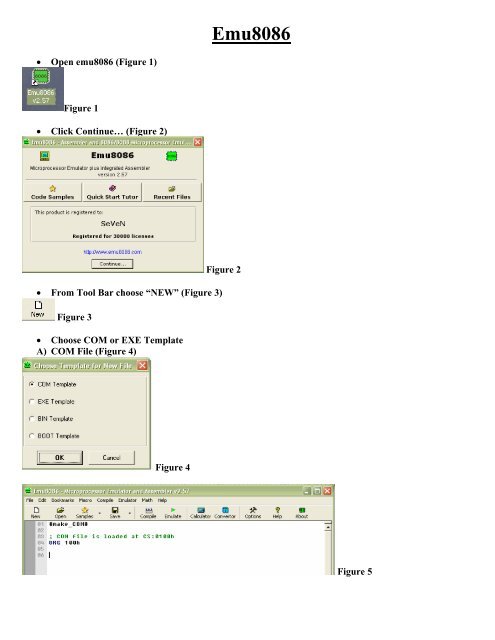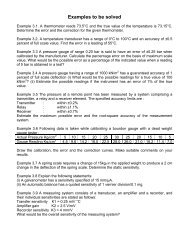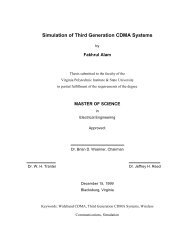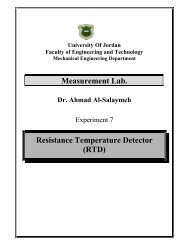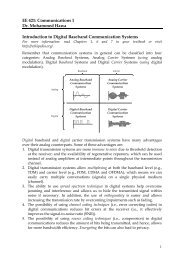Emu8086 Tutorial - FET
Emu8086 Tutorial - FET
Emu8086 Tutorial - FET
Create successful ePaper yourself
Turn your PDF publications into a flip-book with our unique Google optimized e-Paper software.
• When you press Emulate, this window (Figure 10) will appear, it displays the value of all Registers, flags, blockof memory (1K) at a time as Hex value, Decimal value, and ASCII char, and disassembled machine code.You can watch and change them during the executing of your code.Figure 10• This window (Figure 11) views the source code; the highlighted instruction is the next one to be executedFigure 11• To change any register or any memory location, double click on the register (Figure 10), this window(Figure 12) will appear, from Watch select the register then change it as HEX, BIN, or OCTFigure 12
Here we changed the lower byte of AX to 5E instead of 00 (Figure 13)Figure 13Close the window in Figure 13; the value of AX is changed (blue color) (Figure 14)Figure 14• Here we will change tow memory locations at 0B56:01061) Select MEM from Watch (Figure 15).Figure 152) Write the address “segment: offset” 0B56:0106 (Figure 16)Figure 16
3) Change 0B56:0106 to 01 and 0B56:0107 to A6h. (Figure 17)Figure 174) Close the window in Figure 17; the value at offset 0106 and 0107 is changed (Figure 18)Figure 18• To start Running:Press on Single Step (Figure 19)Figure 19At CS:IP one instruction will be executed at a time.• Figure 20 & 21 show the changes after executing MOV AX, 2Figure 20Figure 21• Then press again on Single Step for the next instruction until you finish your code.
Compiling Assembly CodeType your code inside the text area, and click [Compile] button. You will be asked for a place where to savethe compiled file.After successful compilation you can click [Emulate] button to load the compiled file in emulator.The Output File Type Directives:#MAKE_COM##MAKE_BIN##MAKE_BOOT##MAKE_EXE#You can insert these directives in the source code to specify the required output type for the file. Only ifcompiler cannot find any of these directives it will ask you for output type before creating the file.Description of Output File Types:#MAKE_COM# - the oldest and the simplest format of an executable file, such files are loaded with 100hprefix (256 bytes). Compiler directive ORG 100h should be added before the code. Execution always startsfrom the first byte of the file.Supported by DOS and Windows Command Prompt.ORG 100h is a compiler directive (it tells compiler how to handle the source code). This directive is veryimportant when you work with variables. It tells compiler that the executable file will be loaded at the offset of100h (256 bytes), so compiler should calculate the correct address for all variables when it replaces thevariable names with their offsets.Why executable file is loaded at offset of 100h? Operating system keeps some data about the program in thefirst 256 bytes of the CS (code segment), such as command line parameters and etc.#MAKE_EXE# - more advanced format of an executable file. Not limited by size and number of segments.Stack segment should be defined in the program. You may select EXE Template from the New menu in tocreate a simple EXE program with defined Data, Stack, and Code segments.Entry point (where execution starts) is defined by a programmer.Supported by DOS and Windows Command Prompt.#MAKE_BIN# - a simple executable file. You can define the values of all registers, segment and offset formemory area where this file will be loaded. Execution starts from values in CS:IP.This file type is unique to <strong>Emu8086</strong> emulator.
#MAKE_BOOT# - this type is a copy of the first track of a floppy disk (boot sector).Compiler directive ORG 7C00h should be added before the code, when computer starts it loads first track of afloppy disk at the address 0000:7C00.The size of a .BOOT file should be less then 512 bytes (limited by the size of a disk sector).Execution always starts from the first byte of the file.This file type is unique to <strong>Emu8086</strong> emulator.Error ProcessingCompiler reports about errors in a separate information window:MOV DS, 100 - is illegal instruction because segment registers cannot be set directly, general purpose registershould be used:MOV AX, 100MOV DS, AXMOV AL, 300 - is illegal instruction because AL register has only 8 bits, and thus maximum value for it is 255(or 11111111b), and the minimum is -128.Compiler makes several passes before generating the correct machine code; if it finds an error and does notcomplete the required number of passes it may show incorrect error messages. For example:#make_COM#ORG 100hMOV AX, 0MOV CX, 5m1: INC AXLOOP m1MOV AL, 0FFFFh; not a real error!; error is here.RETList of generated errors:(7) Condition Jump out of range!: LOOP m1
(9) Wrong parameters: MOV AL, 0FFFFh(9) Operands do not match: Second operand is over 8 bits!First error message (7) is incorrect, compiler did not finish calculating the offsets for labels, so it presumes thatthe offset of m1 label is 0000, that address is out of the range because we start at offset 100h.Make correction to this line: MOV AL, 0FFFFh (AL cannot hold 0FFFFh value). This fixes both errors! Forexample:#make_COM#ORG 100hMOV AX, 0MOV CX, 5m1: INC AXLOOP m1MOV AL, 0FFh; same code no error!; fixed!RET


